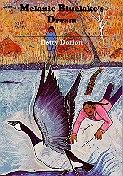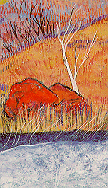


|
Melanie Bluelake's dream.
Betty Dorion.
Grades 4 - 7 / Ages 9 - 12.
|
excerpt:
"Why don't you let us take Melanie until you get on your feet?" asked Doris, the lady from the Native Family Counselling Centre. "She's not going anywhere." Frances' voice was shaking. Melanie covered her mouth with her hand, unable to believe what she was hearing. What had she done? She should never have talked to those women. Her heart pounded in her chest louder, it seemed, than the words she strained to hear Doris went on. "No, I don t mean that we take custody of her. She can stay at the residence until you can take care of her."
 Ten-year-old Melanie Bluelake must leave Elk Crossing, the Cree community in northern Saskatchewan where she lives with her beloved grandmother and her mother, Frances. Her father has left the family to remarry, and Frances decides to return to high school in Prince Albert in the hope of preparing for a job.
Ten-year-old Melanie Bluelake must leave Elk Crossing, the Cree community in northern Saskatchewan where she lives with her beloved grandmother and her mother, Frances. Her father has left the family to remarry, and Frances decides to return to high school in Prince Albert in the hope of preparing for a job.

Recommended for grades four to seven, and as background reading for the teaching of Family Studies and First Nations Societies.
Maryleah Otto is a former children's librarian with the Etobicoke (Toronto) and London, Ontario, Public Libraries, the author of four published books for children, and a member of CONSCRIPT. She has reviewed books regularly for the Ontario Library Association and the Canadian Library Association. She resides in St. Thomas, Ontario where she continues to write for children and adults.
To comment on this title or this review, send mail to cmeditor@mts.net
![]()
Copyright © 1996 the Manitoba Library Association.
Reproduction for personal use is permitted only if this copyright notice
is maintained. Any other reproduction is prohibited without permission.
Published by
The Manitoba Library Association
ISSN 1201-9364
 Go back to CM Welcome page
Go back to CM Welcome page
 Go back to Table of Contents for this Issue
Go back to Table of Contents for this Issue